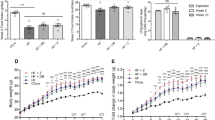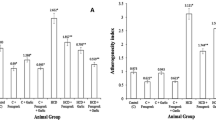Abstract
Exogenous and endogenous cholesterol oxidation products (COPs) perturb various metabolic processes, and thereby they may induce various homeostasis-related disorders. Here, we observed that procyanidin-rich dietary apple polyphenol (APP) from unripe apples alleviates the perturbation of lipid metabolism by decreasing the exogenous COP levels in rats. Dietary COPs may be the greatest source of COPs found in the human body. Rats (4 weeks of age) were fed AIN-purified diets containing 0.3% COPs supplemented with 0.5 or 2.5% APP for 3 weeks. Dietary APP alleviated the growth inhibition action of the exogenous COPs. The modulations of the liver lipid profile by COPs remained unchanged. However, serum total cholesterol, high-density lipoprotein cholesterol, and triglyceride levels increased following the intake of dietary APP. Further, dietary APP inhibited the increase in lipid peroxide levels in the liver and serum by COPs. The activity of hepatic Δ6 desaturase was lowered by dietary APP in a dose-dependent manner, although exogenous COPs generally increased the activity of this enzyme. In keeping with this observation, Δ6 desaturation indices in the phospholipids and cholesteryl esters of the liver and serum lipids were lower in the APP-fed groups than those in the control group. Dietary APP also promoted the excretion of exogenous COPs, cholesterol, and acidic steroids in feces. Therefore, the inhibition of intestinal absorption of COPs may partly contribute to the alleviation of the perturbation of lipid metabolism and lipid peroxidation levels. Thus, APP may be an important removal agent of exogenous toxic material such as COPs contained in processed or fast foods.



Similar content being viewed by others
Abbreviations
- APP:
-
Apple polyphenol
- COP:
-
Cholesterol oxidation product
- FID:
-
Flame ionization detector
- GLC:
-
Gas–liquid chromatography
- HDL:
-
High-density lipoprotein
- HMG-CoA:
-
3-Hydroxy-3-methylglutarylcoenzyme A
- HPLC:
-
High-performance liquid chromatography
- 6-Keto-PGF1α :
-
6-Ketoprostaglandin F1α
- mRNA:
-
Messenger RNA
- PC:
-
Phosphatidylcholine
- PE:
-
Phosphatidylethanoleamine
- PGI2 :
-
Prostacyclin
- SOD:
-
Superoxide dismutase
- TBARS:
-
Thiobarbituric acid reactive substances
References
Paniangvait P, King AJ, Jones AD, German BG (1995) Cholesterol oxides in foods of animal origin. J Food Sci 60:1159–1174
Lake RJ, Scholes P (1997) Quality and consumption of oxidized lipids from deep-frying fats and oils in New Zealand. J Am Oil Chem 74:1065–1068
Lake RJ, Scholes P (1997) Consumption of cholesterol oxides from fast foods fried in beef fat in New Zealand. J Am Oil Chem 74:1069–1075
Osada K, Sasaki E, Sugano M (1994) Lymphatic absorption of oxidized cholesterol in rats. Lipids 29:555–559
Osada K, Kodama T, Cui L, Ito Y, Sugano M (1994) Effects of dietary oxidized cholesterol on lipid metabolism in differently aged rats. Biosci Biotechnol Biochem 58:1062–1069
Osada K, Kodama T, Noda S, Yamada K, Sugano M (1995) Oxidized cholesterol modulates age-related change in lipid metabolism in rats. Lipids 30:405–413
Osada K, Kodama T, Yamada K, Nakamura S, Sugano M (1998) Dietary oxidized cholesterol modulates cholesterol metabolism in rats fed high-cholesterol diet. Lipids 33:757–764
Smith LL, Johonson BH (1989) Biological activities of oxysterols. Free Radic Biol Med 7:285–352
Osada K, Inoue T, Nakamura S, Sugano M (1999) Dietary soybean protein moderates the deleterious disturbance of lipid metabolism caused by exogenous oxidized cholesterol in rats. Biochim Biophys Acta 1427:337–350
Matsumoto N, Okushio K, Hara Y (1998) Effect of black tea polyphenols on plasma lipids in cholesterol-fed rats. J Nutr Sci Vitaminol 44:337–342
Vidal R, Hernandez-Vallejo S, Pauquai T, Texier O, Rousset M, Chambaz J, Demignot S, Lacorte JM (2005) Apple procyanidins decrease cholesterol esterification and lipoprotein secretion in Caco-2/TC7 enterocytes. J Lipid Res 46:258–268
Ikeda I, Imasato Y, Sasaki E, Nakayama M, Nagao H, TakeoT, Yayabe F, Sugano M (1992) Tea catechins decrease micellar solubility and intestinal absorption of cholesterol in rat. Biochim Biophys Acta 1127:141–146
Yang TT, Koo MW (2000) Chinese green tea lowers cholesterol level through an increase in fecal lipid excretion. Life Sci 66:411–423
Leth T, Jusrensen U (1998) Analysis of flavonoids in fruits, vegetables and beverages by HPLC-UV and LC-MS and estimation of the total daily flavonoids intake in Denmark. In: Amado R, Andersson H, Bardocz S, Serra F (eds) Polyphenols in food. Office for official publications of the European communities, Luxembourg, pp 39–40
Macheix JJ, Fleuriet A, Billot J (1990) Changes and metabolism of phenolic compounds in fruits. In: Macheix JJ, Fleuriet A, Billot J (eds) Fruit phenolics. CRC, Boca Raton, pp 149–237
Ohnishi-Kameyama M, Yanagida A, Kanda K, Nagata T (1997) Identification of catechin oligomers from apple (Malus pumila cv. Fuji) in matrix-associated laser desorption/ionization time-of-flight mass spectrometry and fast-atom bombardment mass spectrometry. Rapid Commun Mass Spectrom 11:31–36
American Institute of Nutrition (1997) Report of the AIN Ad Hoc committee on standard for nutritional studies. J Nutr 107:1340–1348
Sevensson L (1988) The effect of dietary partially hydrogenated marine oils on desaturation of fatty acids in rats. Lipids 18:171–178
Lowry OH, Rosebsough NJ, Farr AL, Randall RJ (1951) Protein measurement with the Folin phenol reagent. J Biol Chem 193:265–275
Oyanagui Y (1984) Reevaluation of assay methods and establishment of kit for superoxide dismutase activity. Anal Biochem 142:290–296
Yagi K (1976) A simple fluorometric assay for lipoperoxides in blood plasma. Biochem Med 15:212–216
Ohkawa H, Ohishi N, Yagi K (1979) Assay for lipid peroxides in animal tissues by thiobarbituric acid reaction. Anal Biochem 95:351–358
Folch J, Lees M, Sloane-Stanley GH (1957) A simple method for the isolation and purification of total lipids from animal tissues. J Biol Chem 226:497–506
Kawakami Y, Tsurugasaki W, Yoshida Y, Igarashi Y, Nakamura S, Osada K (2004) Regulative actions of dietary soy isoflavone on biological antioxidative system and lipid metabolism in rats. J Agric Food Chem 52:1764–1768
Ikeda I, Tomari Y, Sugano M (1989) Interrelated effects of dietary fiber and fat on lymphatic cholesterol and triglyceride absorption in rats. J Nutr 119:1383–1387
Sugano M, Yamada Y, Yoshida K, Hashimoto Y, Matsuo T, Kimoto M (1988) The hypocholesterolemic action of the undigested fraction of soybean protein in rats. Atherosclerosis 172:115–112
Osada K, Kodama T, Yamada K, Sugano M (1993) Oxidation of cholesterol by heating. J Agric Food Chem 41:1198–1202
Bruckner GG, Lokesh B, German B, Kinsella JE (1984) Biosynthesis of prostanoids, tissue fatty acid composition and thrombotic parameters in rats fed diets enriched with docosahexaenoic (22:6n-3) or eicosapentaenoic (20:5n-3) acid. Thromb Res 34:479–497
Duncan DB (1955) Multiple range and multiple F test. Biometrics 11:1–42
Nakatsugawa K, Kaneda T (1980) Absorption of methyl linolate hydroperoxides in rabbit. J Jpn Oil Chem Soc 30:74–77
Nakatsugawa K, Kaneda T (1983) Absorption and metabolism of methyllinolate hydroperoxides in rat. J Jpn Oil Chem Soc 32:361–366
Kandutsch AA, Heiniger HJ, Chen HW (1977) Effects of 25-hydroxycholesterol and 7-ketocholesterol, inhibitor of sterol synthesis, administered orally to mice. Biochim Biophys Acta 486:260–272
Koba K, Wakamatsu K, Obata K, Sugano M (1993) Effects of dietary proteins on linoleic acid desaturation and membrane fluidity in rats liver microsomes. Lipids 28:457–464
Hochgraf E, Mokady S, Cogan U (1997). Dietary oxidized linoleic acid modifies lipid composition of rat liver microsomes and increases their fluidity. J Nutr 127:681–686
Lahous Z, Astruc ME, Crastes de Paulet A (1988) Serum-induced arachidonic acid release and prostaglandin biosynthesis are potentiated by oxygenated sterols in NRK 49F cells. Biochim Biophys Acta 958:396–404
Lahous Z, Vial H, Michel F, Crastes de Paulet A, Astruc ME (1991) Oxysterol activation of arachidonic acid release and prostaglandin E2 biosynthesis in NRK 49F cells is partially dependent on protein kinase C activity. Cell Signal 3:559–567
Ruzaidi A, Amin I, Nawalyah AG, Hamid M, Faizul HA (2005) The effect of Malaysian cocoa extract on glucose levels and lipid profiles in diabetic rats. J Ethnopharmacol 98:55–60
Kobayashi M, Unno T, Suzuki Y, Nozawa A, Sagesaka Y, Kakuda T, Ikeda I (2005) Heat-epimerized tea catechin disease prevention. In: Rodriguez H, Cutler RG (eds) Critical reviews of oxidative stress and aging, advances in basic science, diagnostics and intervention, vol 1. World Scientific, Singapore, pp 640–660
Osada K, Suzuki T, Sami M, Ohta Y, Kanda T, Ikeda M (2006) Dose-dependent hypocholesterolemic actions of dietary apple polyphenol in rats fed cholesterol. Lipids 41:133–140
Bagchi D, Preuss HG (2002) Oligomeric proanthocyanidins in human health and disease prevention. In: Rodriguez H, Cutler RG (eds) Critical reviews of oxidative stress and aging, advances in basic science, diagnostics and intervention, vol 1. World Scientific, Singapore, pp 640–660
Shoji T, Masumoto S, Moriichi N, Akiyama H, Kanda T, Ohtake Y, Goda Y (2006) Apple procyanidin oligomers absorption in rats after oral administration: analysis of procyanidins in plasma using the porter method and high-performance liquid chromatography/tandem mass spectrometry. J Agric Food Chem 54:884–892
Anderson JW, Gustafson NJ (1988) Hypocholesterolemic effects of oat and bean products. Am J Clin Nutr 48:749–753
Ogata S, Fujimoto K, Iwakiri R, Matsunaga C, Ogawa Y, Koyama T, Sakai T (1997) Effect of polydextrose on absorption of triglyceride and cholesterol in mesenteric lymph-fistula rats. Proc Soc Exp Biol Med 215:53-58
Hamada T, Goto H, Yamahira T, Sugawara T, Imaizumi K, Ikeda I (2006) Solubility in and affinity for the bile salt micelle of plant sterols are important determinants of their intestinal absorption in rats. Lipids 41:551–556
Author information
Authors and Affiliations
Corresponding author
About this article
Cite this article
Ogino, Y., Osada, K., Nakamura, S. et al. Absorption of Dietary Cholesterol Oxidation Products and Their Downstream Metabolic Effects Are Reduced by Dietary Apple Polyphenols. Lipids 42, 151–161 (2007). https://doi.org/10.1007/s11745-006-3008-2
Received:
Accepted:
Published:
Issue Date:
DOI: https://doi.org/10.1007/s11745-006-3008-2




